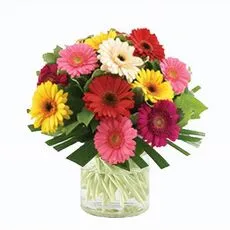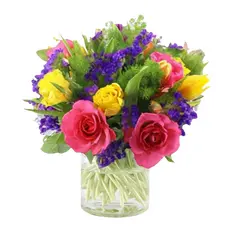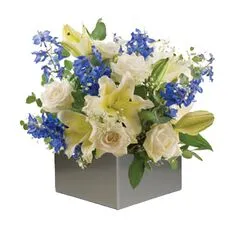Same Day Flowers Delivery - Australia Wide!
Consumer Spending Forecast For Mother's Day 2025

Mother’s Day is one of the busiest periods for Australia’s florists, with single day sales volumes approaching ten times an average day, as noted in Cut Flowers. It’s a cornerstone of the floral industry’s year, often dubbed the “Super Bowl” for flower retailers - at least in America anyway.
Despite economic headwinds in the last 2 years, Australians continue to open their hearts and wallets to celebrate mums and mother figures. This report forecasts consumer spending on flowers for Mother’s Day 2025 in Australia, examining projected expenditures, sales channels, consumer behaviour, pricing, and emerging trends. The analysis draws on industry reports, market research, and historical data to provide a well-supported outlook.
The team and I at Lily's Florist take a deep look into what may eventuate and our predictions for Mother's Day Flowers in 2025. Like all our Florist Lounge blog posts, it require a huge amount of work from myself and the team. You can download a PDF overview of this forecast here.
Our expert tips for florist shops in 2025:
- Expect sales to pick up in the last week of April right through to around May 20
- Encourage your customers to order early, tell them in store, shout it out on your website, ensure you explain the advantages of ordering early
- Be prepared
Projected Spending Overview for 2025
Total Mother’s Day Market
Mother’s Day is now a billion-dollar retail event. Including gifts, dining, and outings, it’s worth roughly $2.0 billion in Australia, with about $200 million of that typically spent just on flowers, as noted by Twinkl. 2024’s surge in flower-gifting (after a dip in 2023) suggests the floral spend will climb higher.
2025 Spending Forecast
Industry analysts anticipate moderate growth in Mother’s Day sales for 2025, barring any economic downturns. Even with some households tightening budgets, total gift expenditure is likely to exceed $1 billion for the first time. We project around a 4–6% increase in spending, putting 2025 Mother’s Day sales in the vicinity of $1.04–$1.06 billion (up from $995M). This outlook aligns with the broader retail trend of “continued modest industry growth…driven by essential gifting occasions despite economic challenges,” as reported by Lily’s Florist.
Flowers Category Outlook
Flowers are expected to remain the #1 gift choice, commanding a large share of that $1B+ spend. In dollar terms, floral purchases for Mother’s Day 2025 could account for a few hundred million dollars. By way of context, past estimates put flower spending around $200 million for Mother’s Day, and 2024’s return to bouquets was described as a “cash splash” benefitting florists. Given the high demand, it’s plausible that $300 million or more could be spent on flowers in 2025 if current trends hold.
Mother's Day Spending in Australia (2023-2025)
Florists and online flower services are gearing up for another strong season, expecting Australians to “not skimp on showing appreciation to mums,” even if they cut back elsewhere.
Spending Trends and Historical Data
Australia’s Mother’s Day spending has been on a steady rise, and 2025 is expected to set a new record. In 2024, Australians were forecast to spend $995 million on Mother’s Day gifts, up 7.5% from 2023, as noted in Mirage News. Flowers overtook all other gift categories that year, with 41% of shoppers planning to buy flower bouquets for mum.
By comparison, 2023 saw about $925 million in spending, as reported by Roy Morgan, and a lower proportion opting for flowers (only ~16% listed flowers, as many chose food or vouchers). This rebound in floral popularity in 2024 indicates strong momentum going into 2025.
Overall Outlook
The 2025 outlook is optimistic but measured, growth is likely, though not as dramatic as the post-pandemic jump seen in 2023. The combination of slightly improving economic conditions and the enduring cultural importance of Mother’s Day should deliver a small uptick in flower sales on top of last year’s near-record figures.
Brick-and-Mortar vs. Online Flower Sales
In-Store Florists (Brick-and-Mortar)
Local flower shops still capture the majority of sales (roughly 60–70% of the market), as noted by Lily’s Florist. In aggregate, Australia’s physical flower retail industry generates about $1.1 billion annually, according to IBISWorld.
Shoppers value the personalised service and sensory experience of brick-and-mortar florists. seeing and smelling the flowers, getting expert advice, and walking out with an arrangement in hand. Traditional florists also often offer custom designs and last-minute availability, which many customers appreciate for Mother’s Day.
That said, brick-and-mortar operators face stiff competition on convenience and price from other channels. Supermarkets and department stores now sell ready-made bouquets at affordable prices, appealing to last-minute and budget-conscious buyers, as highlighted by Cut Flowers. This forces independent florists to differentiate on quality, creativity, and service.
Online Flower Delivery Platforms
Online sales have been the fastest-growing channel, rising to about 30–40% of the flower retail market by value. Industry research shows online flower shops in Australia reached an estimated $456 million in revenue in 2024–25, according to IBISWorld.
Consumers are increasingly comfortable ordering flowers via websites and apps, especially younger shoppers who are “digital-first.” The online channel offers convenience (schedule delivery straight to Mum’s door), price transparency, and broad selection. Shoppers can easily compare designs and prices across sites, which puts pressure on pricing but empowers consumers to find good value.
Flower Sales by Channel (2024-2025)
Brick & Mortar Strengths
- Personalized service
- Sensory experience
- Custom designs
- Last-minute availability
Online Advantages
- Convenience
- Price transparency
- Broad selection
- Direct delivery to recipient
The growth of online floristry has “snatched market share from traditional flower shops” over the past decade. For Mother’s Day, many Australians now pre-order bouquets online to guarantee timely delivery, avoiding the last-minute rush at stores, as reported by Roy Morgan. Reliable nationwide delivery networks (e.g. Petals, Interflora, and dedicated e-florists) have bolstered confidence in online flower shopping.
While online platforms are booming, they too contend with economic pressures, rising delivery costs and cautious consumer spending. However, they have maintained growth by catering to convenience-oriented customers.
Overall Market Trend
Brick-and-mortar florists still lead in total sales, but online platforms are rapidly expanding their share of the Mother’s Day flower market each year. We anticipate 2025 will continue this trend: robust foot traffic for local florists (especially in the final days before Mother’s Day), alongside double-digit growth in online orders as tech-savvy consumers opt for the ease of clicking to send mum a bouquet.
Retailers that embrace both channels such as a local florist with a strong online ordering system stand to gain the most from the overall spending increase, as noted by Lily’s Florist, yes that is us, in a recent news post.
Consumer Behaviour Trends and Preferences
Resurgence of Traditional Gifts
2024 saw a strong return to classic flower-giving for Mother’s Day. In 2023, amid tighter budgets, many Australians had shifted toward practical gifts like food, wine, or gift vouchers. Flowers took a backseat that year (only 16% chose flowers, while 17% chose alcohol/food), as reported by Roy Morgan. But by Mother’s Day 2024, this reversed, flowers jumped to the top of gift lists (mentioned by 41% of shoppers, far above any other category), according to Mirage News.
Shoppers “shifted back to classic flower-gifting” as a heartfelt way to show love, as noted by Lily’s Florist. This trend suggests that even under economic strain, people crave the personal, sentimental touch that a bouquet offers. Flowers carry emotional symbolism that many felt was especially fitting “after what has been a tough year for many households.”
Generational Patterns
Gen Z (Teens & Early 20s)
Younger shoppers participate in Mother’s Day but on tight budgets. Many are students or early in their careers, so they favour smaller bouquets or single flowers to keep costs down. They’re extremely comfortable with technology and are likely to order via an app or online. This group also seeks “Instagrammable” arrangements and trendy options like dried flowers or sustainable, locally-grown blooms. However, if money is tight, Gen Z will cut back on gifts first, making them highly responsive to discounts and promo codes.
Millennials (Mid-20s to Late 30s)
Millennials are the key spenders in the Mother’s Day flower market. Many now have their own families, so they’re buying flowers not just for their mums but also for spouses and other relatives. They tend to invest in quality flowers for meaningful occasions and are comfortable shopping online. Millennials popularised niche floral styles (e.g., native Australian flowers, rustic or “artisan” arrangements) and are early adopters of subscription flower boxes. While cost-of-living pressures make them value-conscious, those who can afford it won’t hesitate to spend a bit more for a meaningful gift.
Mother's Day Consumer Behaviour Trends
Gift Preferences Shift (2023-2024)
Gift Recipients
Generational Shopping Behaviors
Gen X (40s to Mid-50s)
This group often has the highest spending power and typically values reliability and quality. Gen X buyers purchase premium bouquets from trusted sources, often sticking with a favourite local florist or reputable online service. They are less price-sensitive for significant occasions, focusing on getting classic, high-quality flowers, often with a personalized note. Many are also buying for elderly parents, making the gift even more sentimental.
Baby Boomers (60+)
Boomers are often the recipients of Mother’s Day flowers, but those who buy tend to be traditional and loyal to local florists. If a Boomer is purchasing (e.g., a grandfather buying for his wife on behalf of the family), they typically prefer classic arrangements (roses, lilies, etc.) and the in-store experience. This generation values personal service often visiting florists in person to select flowers and chat with staff. While they don’t drive new trends, Boomers reinforce the baseline demand for flowers each year.
Broader Gifting Habits
The scope of Mother’s Day gifting has been widening. It’s not just one’s own mother who gets honoured. According to Mirage News, about 1 in 5 Australians who buy a Mother’s Day present are gifting someone other than their mum such as grandmothers, mothers-in-law, stepmothers, friends, and partners.
For example, it’s increasingly common for a husband to buy flowers for his wife on Mother’s Day if they have young children celebrating her as a mother. Millennials have driven this trend, recognising spouses who are new mums and other mother figures in their lives. This broader gifting means the overall demand for flowers extends to multiple recipients in some families, boosting sales.

Experience vs. Gift Trade-offs
Some consumers choose celebratory experiences instead of or alongside physical gifts such as taking mum out to lunch or cooking a special meal. In 2024, 20% of Australians planned a café/restaurant outing for Mother’s Day, while 35% hosted a home feast, according to Mirage News.
Rather than reducing flower sales, these experiences often complement flower-giving. A bouquet is frequently brought along to brunch or presented during a family dinner. Flowers can even be a centrepiece of the experience, decorating the table. Even those watching their spending might skip an expensive gift but still pick up a modest bunch of flowers as a meaningful token.
Planning and Timing
Due to high demand, consumers have learned to plan ahead. Many now order flowers well in advance (especially through online services) to secure delivery slots and avoid disappointment, as reported by Roy Morgan. Florists begin Mother’s Day promotions weeks early to encourage pre-booking.
Still, a significant number of shoppers leave it until the last minute, rushing to brick-and-mortar shops on the Friday or Saturday before Mother’s Day. Florists see a spike in walk-in customers in the final 48 hours. This last-minute rush can strain supply, which is why retailers advise customers to pre-order if possible. The trend toward earlier ordering has been growing, but we anticipate a familiar pattern in 2025: steady orders in early May, peaking with a surge of Saturday sales before Mother’s Day.
Summary
Australian consumers blend sentimentality with savvy shopping habits for Mother’s Day flowers. They cherish the tradition of giving flowers (especially in challenging times) while adapting their behaviour whether in spending, shopping preferences (online vs. in-store), or whom they gift. These behavioural insights suggest strong underlying demand for flowers in 2025, with nuanced preferences across different consumer segments.
Price Trends and Affordability Considerations
Pricing dynamics in the floral market are a crucial factor in the 2025 forecast. Over the past year, Australians have faced higher flower prices and pressure on household budgets, affecting how and what they buy for Mother’s Day. Key points regarding price trends and affordability include:
Inflation Impact on Flower Prices
The cost of flowers has risen notably due to inflation and supply chain pressures. Florists in 2024 had to raise prices by an estimated 5–15% on bouquets compared to the previous year. Wholesale flower costs climbed (owing to factors like fuel, import costs, and limited supply of certain blooms), and these increases were passed on to consumers. As a result, an arrangement that might have been $90 last year could be $100 or more this year.
This inflationary effect was a major reason the average spend per Mother’s Day gift-giver jumped from $92 in 2023 to about $102 in 2024 people weren’t necessarily buying more items, but each gift (flowers included) simply cost more. For 2025, there is cautious optimism that inflation will moderate. Indeed, Australia’s overall inflation rate had begun to ease by late 2024. If this trend holds, flower prices in 2025 may not spike as dramatically; we might see low single-digit percentage increases, or prices holding steady for mainstream bouquets. That said, any lingering high fuel or import costs in early 2025 could still keep prices elevated.
Consumer Reactions to Higher Prices
The cost-of-living squeeze has forced consumers to adjust their buying behaviour. In 2024, 400,000 fewer Australians bought Mother’s Day gifts at all (compared to 2023), largely due to financial pressures. Some families sadly had to skip purchases to save money. However, those who did partake generally accepted the higher costs for the sake of the occasion effectively “fewer buyers, but higher spend per buyer.”
As noted, those who could afford to still buying gifts ended up paying a bit more per item, offsetting the drop in number of shoppers. This indicates a prioritisation: many people cut back on discretionary treats for themselves before they would cut back on mum’s special day. For 2025, if economic conditions improve even slightly (e.g. wages catch up to inflation), we could see some of those sidelined gift-buyers return. If not, we expect a similar pattern of a smaller core of consumers willing to splurge on Mum despite belt-tightening elsewhere. In any case, affordability will remain top of mind.
Budget-Conscious Purchasing
With prices up, consumers are indeed more price-conscious and strategic. Shoppers are seeking value for money they want their flower purchases to be meaningful and worth the cost. This has a few manifestations:
- Many buyers now compare prices between florists (easily done online) and look for promotions. If a bouquet is too expensive at one shop, they’ll find a comparable one within budget elsewhere.
- Smaller arrangements and mixed flower bouquets have grown in popularity as cost-savvy options. Instead of a grand $200 premium arrangement, a customer might opt for a lovely $70 mix of seasonal flowers that still makes an impact. Florists report that customers are asking for designs that maximise impact for a given price (e.g. using a few showy blooms with cheaper filler foliage to keep within budget).
- Younger consumers (like Gen Z) in particular are quick to use discount codes or take advantage of off-peak deals. Many online flower start-ups offer 10–15% off for first-time customers or have loyalty programs; these can attract budget-sensitive buyers.
- Some consumers are rethinking what they buy: for example, considering a potted plant or a longer-lasting gift if cut flowers seem too expensive for what you get. However, most still default to flowers given the tradition they might just buy fewer stems for the same effect.
Typical Price Ranges
To gauge affordability, it helps to know the typical price points in 2025. For Mother’s Day flowers in Australia:
- A standard bouquet from a florist (e.g. mixed roses, lilies, gerberas with nice wrapping) often falls in the $50 to $100 range.
- Many popular options cluster around $70–$85 at online retailers for a medium arrangement.
- More elaborate or premium arrangements (larger size, luxury roses or orchids, fancy vase included) can be $150+.
According to industry analysis, it’s common for Australians to budget roughly $50–$150 for flowers + add-ons for Mother’s Day. Add-on gifts like chocolates, champagne, or balloons frequently offered by florists can add $20–$50 extra. So a shopper might spend $100 on flowers and $30 on chocolates, totalling $130.
On the lower end, supermarkets sell simple bunches of carnations or chrysanthemums for as low as $20–$30, providing an ultra-affordable choice (albeit with less presentation and shorter lifespan). These pricing tiers mean there’s a flower gift available for virtually every budget. The challenge for consumers is balancing cost with the desire to give something special. In 2024, many stretched their budgets a bit to ensure mum got a nice bouquet, even if it meant spending more than last year.
We anticipate similar willingness in 2025: people will pay a bit more if needed, but they’ll expect quality in return.
Mother's Day Flower Price Trends
Average Bouquet Price Increase
2025 Price Range Options
Consumer Budget Strategies
Competitive Pricing & Discounts
The competitive landscape also affects affordability. Supermarkets offering cheap flower bundles have already been mentioned they effectively cap how much florists can mark up everyday blooms. Additionally, the proliferation of online flower services has introduced more price competition. Consumers can see dozens of options at different price points, forcing vendors to offer reasonably priced bundles or risk losing sales.
Some florists run Mother’s Day specials (like a free small chocolate box with every $80 spend, or free delivery for orders over a certain amount) to entice customers. Others create bundled packages (e.g. bouquet + candle sets) at a value price. These tactics are all meant to address the affordability concern and capture cost-conscious shoppers.
For 2025, we expect retailers to continue such promotions. Early-bird discounts for orders placed well before Mother’s Day might also appear, as florists try to lock in sales early. All these efforts reflect an industry aware that while consumers want to buy flowers, they also need to feel they can afford it.
Economic Factors
Broader economic indicators frame the pricing discussion. Australia’s interest rates rose through 2023, squeezing disposable income as many households faced higher mortgage payments, this contributed to the cautious spending environment. By 2025, if interest rates stabilise or fall, it could relieve some financial pressure.
Inflation, as noted, is forecast to return closer to the target range (~2–3%) by mid-2025, which should help slow any further price hikes on goods like flowers. Consumer confidence, which was low in early 2024, had begun to improve by late 2024, thanks in part to the hope that the worst of the cost-of-living crunch was passing.
A rise in consumer confidence usually bodes well for retail spending. So, if these positive economic signals hold, Australians might feel a bit more secure financially in May 2025, translating to a willingness to spend on Mother’s Day (or at least, fewer people feeling forced to opt out). This doesn’t mean lavish spending but it could mean slightly more breathing room in budgets, aiding the forecasted modest growth in flower sales.
Conclusion
Mother’s Day 2025 in Australia is set to be another robust season for flower spending, fuelled by enduring traditions and adaptive market trends. We anticipate total consumer expenditure on Mother’s Day flowers will edge higher than last year, driven by a mix of slightly improved economic confidence and the unwavering emotional importance of honouring mums.
While cost-of-living concerns persist, flowers remain a relatively accessible luxury that many Australians prioritise, even if it means going for for a smaller bouquet, they’ll still participate in the gesture. Our forecast calls for a moderate increase in floral sales (on the order of mid-single digits percent), which would push Mother’s Day flower revenues into record territory. Florists and retailers can expect busy storefronts and high online order volumes as the day approaches.
Crucially, the way consumers buy flowers is evolving. Brick-and-mortar florists and online platforms will both share in the gains, with the convenience of e-commerce continuing to expand the overall market. Those retailers who have embraced an omnichannel model stand to capture the broadest customer base. On the consumer side, behavioural trends such as early ordering, gifting to a wider circle of mother figures, and generational differences in spending will all play a part in shaping sales patterns and product preferences.
Price sensitivity will remain a theme: shoppers will seek value and may expect retailers to offer options at various price points, but most are willing to spend a bit more if it means giving a meaningful, high-quality gift to mum.
The influence of industry trends and technology cannot be overstated. Sustainability practices, social media marketing, and improved tech integration are collectively elevating the customer experience and could nudge sales higher by attracting eco-conscious buyers, impulsive “Instagram” buyers, and those lured by easier ordering processes. The Australian flower industry appears to be meeting the challenge, with reports indicating florists have become more innovative and resilient.
Mother’s Day epitomises essential gifting occasions it’s culturally ingrained and emotionally resonant, which gives it a degree of recession resistance.
The Mother’s Day 2025 flower market outlook is one of cautious optimism. We expect record or near-record spending on flowers, with total flower sales likely on the order of a few hundred million dollars and total Mother’s Day retail spending topping approximately $1 billion. The market will be shaped by a blend of tradition and transformation: Australians clinging to the beloved custom of giving flowers while also embracing new ways to shop and new types of floral gifts.
If trends stay on course, Mother’s Day 2025 will not only reaffirm the flower industry’s resilience but also highlight its adaptability in a changing world. Both consumers and florists can look forward to a day of celebration and growth, as bouquets fly off both physical and virtual shelves across Australia.
Sources
- Australian Retailers Association & Roy Morgan – Mother’s Day Spending Reports 2023-2024
- Lily’s Florist – “Consumer Spending on Flowers in 2024” Analysis
- IBISWorld – Australia Flower Retailing & Online Flower Shops Market Data
- Australian Cut Flower Industry – Mother’s Day Market Overview
- Twinkl Australia – Mother’s Day Facts and Figures
- Economic Indicators – RBA & Treasury Forecasts, Trading Economics, Arielle
Blog Categories
Recent posts
- Google Mixboard for Florists: How to Fix the "Client Language Gap" in Consultations
- What is Google Pomelli? The AI Assistant Every Florist Needs
- How to Optimise Your Florist Google Business Profile
- Embed a Google Map on Your Florist Website (The Easy, No-Code Way)
- How Important Is My Florist Shop Address
- Where to Put My Flower Shop Phone Number on My Website?








